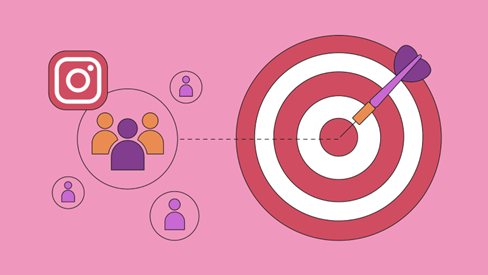In today's dynamic business landscape, understanding your target audience is a pivotal step towards crafting successful marketing strategies. A comprehensive grasp of your audience's preferences, behaviors, and demographics empowers businesses to deliver tailored solutions and experiences.
By delving into these strategies, you'll gain actionable insights to refine your marketing endeavors and forge stronger connections with the individuals most likely to engage with your services.
To further emphasize on the importance of identifying your target audience, here are some important statistics and facts to consider:
- According to HubSpot, 47% of buyers view three to five pieces of content before engaging with a sales representative.
- In a study by Adobe, personalized promotional emails have a 29% higher unique open rate and 41% higher click-through rate compared to non-personalized emails.
- The Pew Research Center highlights that 69% of adults in the United States use at least one social media platform, emphasizing the significance of online platforms for audience engagement.
- A report by McKinsey & Company suggests that companies with a strong customer understanding are 60% more likely to have a loyal customer base.
This article will provide a comprehensive overview of seven effective methods that will show you how to find your target audience and understand them better, enabling you to optimize your marketing efforts for maximum impact.
What Does A Target Audience Mean?
A target audience refers to the specific group of individuals or customers whom a product, service, or message is designed to reach and resonate with. This demographic is characterized by shared characteristics such as age, gender, interests, behaviors, needs, and preferences. Identifying and understanding your target audience is crucial for businesses to tailor their marketing strategies effectively, enabling them to communicate the right message to the right people and drive engagement, conversions, and long-term customer relationships.
Why Defining Target Audience is Important?
Defining a target audience is vital because it streamlines marketing efforts, ensuring that resources are allocated efficiently. By precisely identifying the individuals most likely to be interested in your product or service, you can create tailored messages and experiences that resonate with their specific needs and preferences.
This not only increases the likelihood of engagement but also fosters brand loyalty and long-term customer relationships. Additionally, a well-defined target audience minimizes wastage by reducing the dispersion of marketing materials to audiences who are unlikely to convert, leading to higher ROI and more focused campaigns.
Types of Target Audiences
Demographic Targeting
This approach segments audiences based on demographic attributes such as age, gender, income, education, and occupation. Understanding these characteristics enables businesses to tailor their messaging to align with the preferences and needs of specific demographic groups.
For instance, an apparel brand might target young adults with fashion-forward products and retirees with comfortable and practical clothing options.
Geographic Targeting
Geographic segmentation involves categorizing audiences based on their physical location, such as country, city, or region. This is particularly useful for businesses with location-specific offerings or those aiming to customize their marketing based on regional trends and preferences.
A restaurant chain, for example, can promote different menu items in different cities based on local tastes.
Psychographic Targeting
Psychographic segmentation delves into the psychological and lifestyle attributes of individuals, including their values, interests, beliefs, and personality traits. This method creates more nuanced audience profiles, allowing marketers to craft messages that resonate on a deeper level.
A fitness brand might target health-conscious individuals who value wellness and holistic living.
Behavioral Targeting
Behavioral segmentation revolves around analyzing consumers' past behaviors and actions, such as purchase history, browsing patterns, and engagement with previous marketing efforts. This data-driven approach helps tailor marketing messages to match specific behaviors, increasing the likelihood of conversions.
An e-commerce platform might target frequent online shoppers with personalized recommendations based on their past purchases.
Technographic Targeting
This form of targeting focuses on the technological attributes of the audience, including the devices they use, software preferences, and technological expertise. It's especially relevant in the digital age, allowing businesses to optimize their content for specific platforms and devices.
A software company might target professionals who use certain tools by showcasing compatibility and integration features.
Expert Ways for Identifying Target Audience
1. Analyze Existing Customers
Your current customer base holds valuable insights. Analyze their demographics, behaviors, and purchasing patterns to identify common traits. This target audience analysis can guide you in understanding who your most engaged and loyal customers are, forming the foundation of your target audience profile.
2. Examine Social Media Followers
Study the demographics, interests, and interactions of your social media followers. Platforms like Facebook and Instagram provide analytics that offer a detailed overview of your audience's characteristics. This data aids in refining your target audience by aligning your content and campaigns with the preferences of your social media community.
3. Analyze Content Analytics Data Using Tool
Leverage analytics tools to monitor which types of content resonate most with your audience. Analyze metrics like click-through rates, time spent on pages, and engagement levels to discern what topics and formats are preferred. This data-driven approach assists in shaping your content strategy to cater to the interests of your target audience.
Use Arena Calibrate Tool for Better Data Visualisation
Experience improved data interpretation through the advanced data visualization capabilities offered by the Arena Calibrate Tool. Complex datasets are transformed into accessible insights using intuitive charts, graphs, and visual aids.
Whether you are monitoring keyword performance, analyzing competitor strategies, or evaluating your website's SEO metrics, the tool's enhanced visualization ensures a comprehensive understanding of key insights.
This clarity empowers you to make strategic decisions with confidence, streamlining your optimization efforts and delivering actionable results.
4. Analyze Competitors
Study your competitors' customer base and marketing strategies. Identify the audience they are targeting and assess whether there are overlapping segments you might consider. This analysis provides insights into potential untapped markets or helps you differentiate your approach within shared demographics.
5. Determine who is not your Target Audience
Defining who your product or service isn't intended for is just as crucial as knowing who it is for. This exclusionary approach narrows down your focus, ensuring your resources are spent on individuals who are more likely to convert, resulting in more efficient marketing efforts.
6. Stay Objective and Avoid Assumptions
Base your target audience analysis on data and research rather than assumptions or personal biases. Objectivity ensures you accurately identify your audience's characteristics, behaviors, and needs, leading to more effective marketing strategies.
7. Develop Target Audience Profile
Consolidate the insights gathered from various sources into a comprehensive target audience profile. This profile should encapsulate demographics, psychographics, behaviors, and preferences. Having a detailed and well-defined profile facilitates crafting personalized messages that resonate deeply with your intended audience.
Target Audience Examples
Instagram caters to a diverse audience of primarily young adults and teenagers, aged 13 to 34. It's especially popular among individuals who are visually inclined and seek a platform for sharing photos and videos.
The Instagram target audience also includes influencers, content creators, and businesses looking to engage with a visually-oriented community. With a strong emphasis on visual content and storytelling, Instagram attracts users interested in fashion, beauty, travel, lifestyle, and creative arts.
The platform's interactive features, such as Stories, Reels, and IGTV, draw in those seeking real-time updates and bite-sized entertainment.

Nike
Nike's target audience encompasses active individuals, sports enthusiasts, and athletes of all levels, ranging from casual to professional. The brand caters to people who prioritize fitness, performance, and style in their athletic pursuits.
Nike's marketing campaigns often resonate with the "Just Do It" attitude, appealing to individuals who value determination, self-improvement, and pushing their limits. The brand's reach extends to both genders and various age groups, with a focus on younger generations who appreciate the fusion of technology, innovation, and fashion in sportswear.

Starbucks
Starbucks targets a broad demographic, but its core audience includes urban professionals, students, and young adults who seek a comfortable and trendy space to socialize, work, or relax. The brand appeals to coffee enthusiasts who value quality and diverse beverage options, as well as individuals who appreciate the convenience of on-the-go drinks and snacks.
Starbucks' inclusive and cozy ambiance attracts people looking for a third-place experience beyond home and work. Its loyalty program also caters to repeat customers who enjoy personalized rewards and offerings, making it a go-to spot for a wide range of consumers.

Conclusion
In essence, understanding your target audience is paramount for any successful marketing endeavor. Through comprehensive target audience analysis, you can pinpoint the key demographics, preferences, and behaviors that drive consumer engagement.
Utilizing advanced target audience analysis tools further elevates this process, enabling businesses to gather deeper insights, refine their strategies, and establish meaningful connections with their customers.
By embracing these methods, companies can optimize their marketing approaches, tailor their messages effectively, and ultimately foster stronger brand-consumer relationships, resulting in greater success and growth.
FAQ on Target Audience
What data is important for target audience analysis?
Important data for target audience analysis includes demographics (age, gender, location), psychographics (interests, values), behavioral data (buying habits, interactions), geographic info, technographics (technology preferences), purchase intent, online presence, competitor analysis, feedback, market trends, and segmentation.
Target audience analysis tools aid in gathering and interpreting this data, enhancing marketing strategy by enabling businesses to tailor messages, improve user experience, and anticipate customer needs.
How can target audience analysis enhance my marketing campaigns?
Target audience analysis enhances marketing campaigns by enabling precise messaging, customized content, optimized channel selection, improved user experience, targeted advertising, better product development, higher conversion rates, improved ROI, stronger brand-customer relationships, adaptation to trends, minimized guesswork, and segmentation/personalization strategies.
It ensures your efforts are directed towards the right people with messages that resonate, resulting in more impactful and successful campaigns.
Which are the three aspects of a target audience?
The three aspects of a target audience are:
- Demographics
- Psychographics
- Behaviors
Understanding and analyzing these three aspects collectively allows you to create a comprehensive profile of your target audience, helping you tailor your marketing strategies effectively.
How can competitor analysis assist in identifying your target audience?
Competitor analysis can play a crucial role in identifying your target audience by providing valuable insights into the audience that is already engaging with your competitors' products or services. Here's how competitor analysis can assist in this process:
Shared Audience Characteristics: By analyzing your competitors' customer base, you can identify common demographics, psychographics, and behaviors that are prevalent among their audience. This can give you a starting point for understanding who might also be interested in your offerings.
Unmet Needs and Gaps: Through competitor analysis, you may uncover segments of the market that your competitors are not effectively addressing. These unmet needs or gaps could present an opportunity for you to target a specific audience that is underserved.
Segment Validation: If you've identified potential target audiences but are unsure if they are worth pursuing, seeing if your competitors are successfully engaging with similar segments can validate the viability of those segments.




